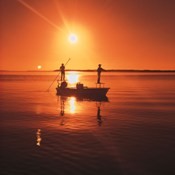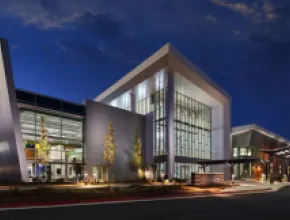It’s all a matter of perspective in the Florida Keys. From the air, they look like a trail of breadcrumbs leading from the mainland toward the turquoise waters of the Gulf of Mexico.
From the water, the islands seem remote and exotic, a fragile strip of land bisecting endless miles of blue sea stretching toward the horizon.
And from the highway—the Overseas Highway, that is—the Keys offer a road trip like no other, leapfrogging from island to island via scenic bridges and tracts of land so narrow that both sides of the road boast a waterfront view.
It takes about an hour to get from Miami to Key Largo—the northernmost Key—and another two-and-a-half hours to reach Key West, the end of the road. And though Key West International Airport welcomes regular service from Orlando, Atlanta, Miami, and Fort Lauderdale, most visitors consider the drive to be part of the overall experience.
“Only about 10 percent of those coming into Key West will come via air,” says Jack Meier, destination sales manager for the Florida Keys and Key West, the promotional brand of the Monroe County Tourist Development Council. “Most folks take advantage of the pre and post schedule, taking their time coming down and going back up.”
Indeed, the Florida Keys seem to have a knack for getting people to take their time. Slow down. Stop and smell the mangroves. Even for travelers with business on their minds—meeting and convention groups, for instance—the Keys offer a laid-back, creative environment for getting work done.
“Whether you’re looking for something within the traditional meeting scope, as far as isolating the group and having them focus on the task at hand, as well as interacting with the environment during the meeting, we offer both,” Meier says. “You can incorporate the outside into the inside to make the event more interesting visually as well as aesthetically.”
It all depends on your perspective.
Upper Keys
Driving in from mainland Florida, visitors enter the 125-mile island chain at Key Largo, the longest island in the Keys and home to the first underwater preserve in the U.S.—John Pennekamp Coral Reef State Park, part of the Florida Keys National Marine Sanctuary, whose protected waters shelter 55 varieties of delicate corals and more than 600 different species of fish.
Another bonus for divers in Key Largo: the Spiegel Grove, a retired U.S. Navy ship that is one of the largest vessels ever to be purposely scuttled for the creation of an artificial reef.
Back on dry land, groups can congregate after-hours at the Caribbean Club, a local bar that was featured in the 1947 Bogie and Bacall classic, Key Largo, or forgo the lounge lizards for rare tree snails, swallowtail butterflies and mangrove cuckoos on a hike through the Key Largo Hammock Botanical State Park.
While Key Largo retains a certain timeless tropical charm—as do all the Keys—meeting facilities are on the move. The Sheraton Beach Resort Key Largo, for example, recently became the Key Largo Grande Resort and Beach Club, with 200 rooms and 10,000 square feet of function space, while the Marriott Key Largo Bay Resort unveiled the 5,000-square-foot Largo Key Conference Center, the newest venue within the resort’s 15,000 square feet of meeting space.
Key Largo also offers a range of options for groups of various sizes, from more than 30,000 square feet of flexible function space—including a ballroom and conference complex—at the secluded Ocean Reef Club on the north end of the island, to a modest 2,500 square feet of meeting space at the Marina del Mar Resort.
They may have been named for a snail, but great fishing put Islamorada on the map. This group of islands following Key Largo was dubbed “islas moradas”—morada meaning purple—by Spanish explorers who noted the vivid violet sea snails carpeting the beaches as they sailed by. Several hundred years later, Islamorada was hailed as the “Sportfishing Capital of the World” thanks to its angling diversity—sailfish, marlin, snapper, and grouper are among the prize catches—and the largest fleet of offshore charter boats and shallow-water “backcountry” boats in the Keys.
Fishing excursions depart daily from Islamorada’s largest meetings property, Cheeca Lodge, where a team of chefs can not only prepare a box lunch for your adventure, but prepare your catch to order that night. The 27-acre property also offers a 4,000-square-foot conference center and the lavish Spa at Cheeca Lodge, along with on-site golf, tennis and a kids’ camp.
Also serving groups in Islamorada is the newly renovated Islander, featuring 114 guest rooms, two meeting rooms that can handle up to 90 people, a 25-person boardroom, a courtyard area available for group functions, and a 1,000-foot-long beachfront available for events.
Middle Keys and Lower Keys
Driving along the Overseas Highway through Marathon—midpoint of the Florida Keys—repeat visitors might notice renewed activity at Florida Keys Marathon Airport, where commercial air service returned in February with the debut of Delta Connection’s daily nonstop service to and from Atlanta. It’s a convenient option, considering that both Key West and Key Largo are an hour’s drive away.
But if your group stays in Marathon or anywhere else in the Middle Keys, they won’t be disappointed. Local attractions include the Dolphin Research Center—where guests can swim and interact with the highly intelligent mammals—and the archaeologically valuable Crane Point, a 63.5-acre tract of land containing evidence of pre-Columbian artifacts.
The Middle Keys also are home to one of the island chain’s largest convention properties—Hawk’s Cay Resort—featuring a 25,000-square-foot waterfront conference center and extensive on-site recreation, including its own dolphin encounter program and a full-service spa.
Meanwhile, the new kid on the meetings block is Tranquility Bay Beach House Resort, comprising 87 two-story beach homes and offering 2,025 square feet of flexible event space in addition to outdoor venues that include a private beach directly on the Gulf of Mexico. The resort recently installed wireless Internet service throughout the property and plans to add another 2,025 square feet of event space.
The Middle Keys end at the Seven Mile Bridge—the longest segmental bridge in the world—which leads to the Lower Keys, known as the “Natural Keys” due to the area’s emphasis on responsible utilization and preservation of an array of natural wonders that include two national wildlife refuges, a national marine sanctuary and a state park.
Not surprisingly, there are no major resorts in this nature-centric region; instead, small groups can gather at Little Palm Island Resort and Spa, located just offshore from Little Torch Key and accessible only by seaplane or boat, and at the newly renovated Parmer’s Resort on Little Torch Key, whose extensive upgrades included the addition of a 1,500-square-foot luxury penthouse suite named The Palms, a great option for incentives or VIP gatherings.
Key West
The last stop on the Overseas Highway is Key West, the southernmost city in the continental U.S. But not only is Key West unlike any U.S. city you’ll ever visit, it’s also quite distinct from the rest of the Keys.
Sure, you’ll find the same diving, boating and beaches, but you’ll also see Victorian mansions (many housing guesthouses and restaurants) lining the tree-shaded streets; military forts and heritage sites, including the East Martello Museum & Gallery and Fort Zachary Taylor Historic State Park; a Bahamian village with a marketplace, restaurants and art galleries; and a bohemian spirit that pervades the entire two-by-four-mile island.
Meanwhile, a list of other attractions reads like a who’s who of the famous and infamous who have left their mark on Key West: the Harry S. Truman Little White House; the Ernest Hemingway Home & Museum; the Tennessee Williams Theatre; the Mel Fisher Maritime Museum; the Audubon House & Tropical Gardens; the San Carlos Institute (where Jose Marti launched his plan for Cuba’s independence from Spain); and the Oldest House/Wrecker’s Museum, whose artifacts recall the island’s days as a lucrative haven for Bahamian wreckers.
With so much to discover, it might be a challenge to keep your group focused, but Key West’s many meetings hotels and resorts are up to the task. Larger properties include the Casa Marina Resort and Beach Club, which dates back to 1920 and includes 11,000 square feet of meeting space and 311 guest rooms. The property is currently undergoing a refurbishment. Another oldie-but-goodie is the 1920s-era Crowne Plaza La Concha, offering the Island Room for intimate gatherings, a multilevel sundeck for outdoor events and The Top observation deck, where groups enjoy panoramic views and stunning sunsets.
One of the island’s newer properties is the 216-room Doubletree Grand Key Resort, with 7,000 square feet of meeting space. The resort recently reopened following a two-month closure for property enhancements and safety and operational upgrades.
And if you’re looking for brand-new, the Beachside Resort and Conference Center will open this fall with facilities that include a grand ballroom and a private dining room for up to 25.
Other group options in the “Southernmost City” include the Hyatt Key West Resort and Marina, the Ocean Key Resort and Spa, the Pier House Resort and Caribbean Spa, and the Westin Key West Resort and Marina.






